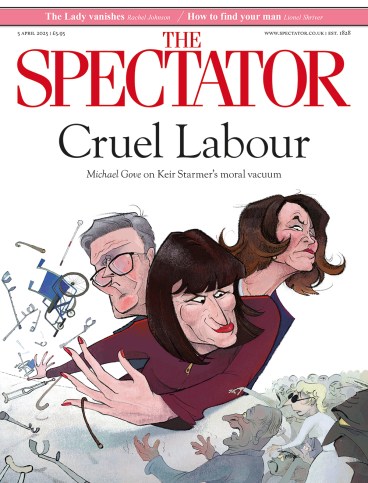
You feel so close to Victor Hugo in this exhibition. It’s as if you are at his elbow while he sighs at his standing desk at the top of his house on Guernsey, where he held France constantly in view as he worked. Here, frustrated by Les Misères (working title), he has thrown down his pen and moved to his art table, sloshing great washes of sepia ink across paper to form lowering clouds. And there, daydreaming, he has cut out a stencil of a castle, and placed it on a cloud of ink. (Hmm, ‘castle on a cloud’ – could make a nice lyric for a song one day…)
Here is a person thinking with their pen – or rather, letting their pen think with them
There is a wonderful intimacy to his travel sketchbooks, full of minutely well-observed brickwork and staircases. And also to his doodles, inkblots, taches (stains), his ghosties (made by printing with scraps of lace) and other high-spirited caricatures, created in the 1830s late at night while chatting and debating with friends. One recalled how Hugo placed these sketches ‘every evening on his children’s beds and which they find when they wake up in the morning, to their great joy’. Then there are his mysterious notebooks of wiggly lines, possibly a form of automatic drawing or shadow-tracing. By the time he made these, he had been living in exile on Guernsey for a decade, and he had started using séances to converse, via a Ouija board, with Joan of Arc, Shakespeare, Napoleon, and even Death itself, which clearly marked an uptick to his social life.
Most of these works were never intended for display – too odd (that menacing mushroom!) – and were instead a distraction, a re-creation, a way back into his written work, a summoning of dramatic atmosphere, of mood, made, as Hugo said, ‘in the margins or on the covers of manuscripts during hours of almost unconscious reverie with what remained of the ink in my pen’. The work is ‘not illustrative, but generative’ as the catalogue pithily puts it.
Here is a person thinking with their pen – or rather, letting their pen think with them. The ink flows or blots as it will, a process that in turn feeds the imagination. (A feedback loop we all used to know, before we stopped being Homo faber and started being screen-ticklers.)
There is a spooky absence of colour – the whole exhibition runs from jet black to chalky white gouache with most pictures a sepia or caffeine mid-tone. And yet Hugo had a brilliant eye for colour; he furnished Hauteville House on Guernsey with a stunning combination of Chinese reds and assertive yellows, with pink-and-yellow patterns and pelmets, cast into a constant play of chiaroscuro by dramatic lightwells and louvres. Hugo cut baronial bric-à-brac up into dramatic domestic stage sets, and signed the whole thing with a huge ‘H’ made out of blue Delft tiles. A recent restoration has brought back the original brightness, and Hauteville House remains a must-visit, even though in this exhibition it is represented only in the form of tiny photographs from the 1860s – weird choice. Why not go for it and recreate a room? You only do Hugo at the RA once a lifetime.
His art remaining so steadfastly monochrome seems like another stylish decision – or an indication that his first intention was to write with the ink, rather than draw with it. But in the latter part of the exhibition, we move from private work to the showstoppers that he sent forth to accompany his 1866 novel Toilers of the Sea to print (though you have to truffle the catalogue to find this out). These are intensely dramatic pictures of lighthouses, sea creatures and shipwrecks. The monochrome was presumably in order that they could be reproduced as such.
By the time he made his mysterious notebooks of wiggly lines, Hugo was using a Ouija board
Oddly, there are no attempts at realism when it comes to people. There is one caricature of a face. There is an outline of a hanged man – a campaigning image against the death penalty. And there is a skull, which appears in an inkblot shadow of the poisonous Manchineel tree – drawn in crisis during the trip to Spain when he found out, by reading the newspaper, that his daughter Leopoldine had drowned in a boating accident. Otherwise, all his great capacity for human sympathy went into his masterworks. Here, there is only the impervious face of an octopus, drawn, possibly, in its own ink.








Comments